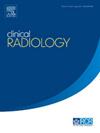Clinical evaluation of [18F]fluoro-2-deoxy-d-glucose positron emission tomography-magnetic resonance imaging ([18F]FDG PET-MRI) and [18F]FDG PET-computed tomography ([18F]FDG PET-CT) for lymph node assessment in head and neck squamous cell carcinoma
IF 1.9
3区 医学
Q2 RADIOLOGY, NUCLEAR MEDICINE & MEDICAL IMAGING
引用次数: 0
Abstract
AIM
This retrospective study evaluated the accuracy of hybrid 2-[18F]fluoro-2-deoxy-d-glucose ([18F]FDG) positron emission tomography-magnetic resonance imaging (PET-MRI) and [18F]fluoro-2-deoxy-d-glucose positron emission tomography-computed tomography ([18F]FDG PET-CT) for lymph node assessment in patients with head and neck squamous cell carcinoma (HNSCC) within routine clinical care.
MATERIALS AND METHODS
Patients with HNSCC underwent either [18F]FDG PET-MRI or [18F]FDG PET-CT following a dedicated head and neck and whole-body protocol. Data on lymph nodes, both individually and pooled by ipsilateral and contralateral sides, were extracted from [18F]FDG PET-MRI/-CT reports. Lymph nodes and sides were categorised as malignant, suspicious, or benign. As a reference standard, results from pathology, follow-up imaging, or the conclusion established by a multidisciplinary team were used. Both lesion-wise and patient-wise analyses were performed.
RESULTS
A total of 256 patients were included: 130 underwent [18F]FDG PET-MRI (mean age 65 ± 11, 69% male) and 126 underwent [18F]FDG PET-CT (mean age 68 ± 10, 69% male). For lymph nodes classified as malignant or benign, both modalities showed high true-positive and negative rates (96–100%) in both lesion- and patient-wise analyses. Lymph nodes deemed suspicious on [18F]FDG PET-MRI and [18F]FDG PET-CT were pathologically confirmed as malignant in 18% and 9% of cases, respectively.
CONCLUSION
[18F]FDG PET-MRI/-CT demonstrate high accuracy in identifying malignant and benign lymph nodes. [18F]FDG PET-MRI shows slightly higher accuracy for suspicious lymph nodes, although diagnostic challenges remain. Advancements in imaging techniques and disease-specific tracers may improve lymph node evaluation in HNSCC, warranting prospective clinical trials to ultimately reduce reliance on pathological confirmation and minimise diagnostic delays.
[18F]氟-2-脱氧-d-葡萄糖正电子发射断层扫描-磁共振成像([18F]FDG PET-MRI)和[18F]FDG pet -计算机断层扫描([18F]FDG PET-CT)对头颈部鳞状细胞癌淋巴结评估的临床评价
目的:本回顾性研究评估2-[18F]氟-2-脱氧-d-葡萄糖([18F]FDG)正电子发射断层扫描-磁共振成像(PET-MRI)和[18F]氟-2-脱氧-d-葡萄糖正电子发射断层扫描-计算机断层扫描([18F]FDG PET-CT)在常规临床护理中用于头颈部鳞状细胞癌(HNSCC)患者淋巴结评估的准确性。材料和方法HNSCC患者在专门的头颈部和全身方案下接受[18F]FDG PET-MRI或[18F]FDG PET-CT检查。从[18F]FDG PET-MRI/-CT报告中提取淋巴结的数据,无论是单独的还是同侧和对侧的汇总数据。淋巴结和两侧分为恶性、可疑和良性。作为参考标准,病理结果、随访影像或多学科小组确定的结论被使用。进行病变分析和患者分析。结果共纳入256例患者:[18F]FDG PET-MRI患者130例(平均年龄65±11岁,男性69%),[18F]FDG PET-CT患者126例(平均年龄68±10岁,男性69%)。对于分类为恶性或良性的淋巴结,在病变和患者分析中,这两种模式都显示出很高的真阳性和阴性率(96-100%)。[18F]FDG PET-MRI和[18F]FDG PET-CT病理证实为恶性的淋巴结分别为18%和9%。结论[18F]FDG PET-MRI/-CT对良恶性淋巴结的鉴别准确率较高。[18F]FDG PET-MRI显示可疑淋巴结的准确性略高,尽管诊断仍存在挑战。成像技术和疾病特异性示踪剂的进步可能会改善HNSCC的淋巴结评估,保证前瞻性临床试验最终减少对病理确认的依赖并最大限度地减少诊断延误。
本文章由计算机程序翻译,如有差异,请以英文原文为准。
求助全文
约1分钟内获得全文
求助全文
来源期刊

Clinical radiology
医学-核医学
CiteScore
4.70
自引率
3.80%
发文量
528
审稿时长
76 days
期刊介绍:
Clinical Radiology is published by Elsevier on behalf of The Royal College of Radiologists. Clinical Radiology is an International Journal bringing you original research, editorials and review articles on all aspects of diagnostic imaging, including:
• Computed tomography
• Magnetic resonance imaging
• Ultrasonography
• Digital radiology
• Interventional radiology
• Radiography
• Nuclear medicine
Papers on radiological protection, quality assurance, audit in radiology and matters relating to radiological training and education are also included. In addition, each issue contains correspondence, book reviews and notices of forthcoming events.
 求助内容:
求助内容: 应助结果提醒方式:
应助结果提醒方式:


